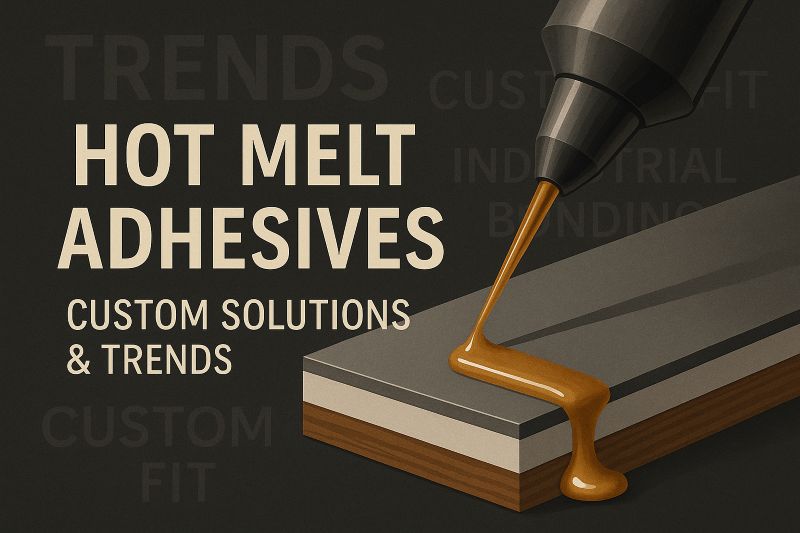
Definition of Hot Melt Adhesives
Types of Hot Melt Adhesives
Importance of Custom Solutions
Adhesive Application Methods
Latest Trends in Adhesives
Strategies for Unique Needs
Case Studies of Custom Solutions
Frequently Asked Questions (FAQ)
Hot melt adhesives are thermoplastic bonding agents that liquefy when heated and solidify upon cooling, forming durable connections between materials. These adhesives are favored for their rapid bonding capabilities and adaptability across a wide range of applications. For complex or non-standard requirements, customized hot melt adhesive solutions can be formulated to improve both performance and operational efficiency.
Hot melt adhesives are available in various formulations, each serving different industrial purposes:
EVA (Ethylene-Vinyl Acetate): Known for versatility and affordability, commonly used in packaging and printing.
Polyamide: Offers high heat resistance, ideal for automotive and electronic applications.
Polyolefin: Provides flexibility and good adhesion, suited for textiles and woodworking.
Polyurethane (PUR): Delivers strong and durable bonds, especially in outdoor or high-stress environments.
Custom formulations built on these base types allow for optimized performance across specific end-use scenarios.
Off-the-shelf adhesives may not always meet the unique needs of specialized applications. Custom hot melt adhesive solutions are essential for achieving precise performance standards. Whether it's withstanding elevated temperatures, adhering to difficult substrates, or accelerating cure times, tailored adhesive development enables industries to address their challenges directly—improving both product quality and production efficiency.
Selecting the appropriate adhesive application method is crucial to achieving reliable and efficient bonding results. Common methods include:
Spray application: Ensures uniform coverage for large or uneven surfaces.
Slot die coating: Offers precision for controlled, repeatable patterns.
Wheel application: Ideal for high-speed production environments requiring consistent adhesive flow.
Matching the right technique with the correct adhesive formulation helps reduce waste and maximize bond performance.
The adhesive sector is evolving rapidly in response to new industrial and environmental demands:
Eco-friendly formulations are reducing environmental impact while maintaining performance.
Improved resistance to heat and moisture allows adhesives to serve in increasingly demanding conditions.
Customization and modular formulation design are becoming mainstream to meet unique application challenges.
These trends reflect a broader push toward sustainable, efficient, and high-performance bonding technologies.
Addressing specialized bonding needs requires a strategic, consultative approach:
Assess performance requirements, including heat, stress, and substrate compatibility.
Collaborate with materials engineers or adhesive experts to refine formulation characteristics.
Select the best application tools and techniques to align with production goals.
Evaluate long-term performance and cost efficiency to ensure the solution is scalable.
A strategic, customized approach helps ensure that adhesives meet both operational demands and budgetary constraints.
Real-world examples illustrate the effectiveness of custom hot melt adhesive solutions:
A packaging company required bonding for eco-friendly materials; a custom solution was developed that balanced sustainability with adhesion strength.
An automotive parts manufacturer needed high-temperature durability; a specialized heat-resistant formulation improved part longevity.
A textile firm faced bonding issues with delicate fabrics; a flexible adhesive was customized for non-damaging precision bonding.
An electronics assembly line required moisture resistance; a high-performance hot melt adhesive ensured reliable bonding in humid environments.
These scenarios demonstrate how tailored adhesive solutions solve complex industrial challenges and unlock new design possibilities.
What are hot melt adhesives?
They are thermoplastic adhesives that melt when heated and solidify upon cooling, offering fast bonding and adaptability across applications.
What are the main types of hot melt adhesives?
Common types include EVA, polyamide, polyolefin, and polyurethane, each designed for specific bonding challenges.
Why are custom hot melt adhesive solutions important?
Because they address unique performance demands—such as extreme temperatures or surface compatibility—that off-the-shelf products may not.
What are common adhesive application methods?
Spray, slot die coating, and wheel application are frequently used depending on surface area, speed, and precision needs.
What trends are shaping the adhesive industry?
Sustainability, enhanced durability, and demand for application-specific customization are key trends driving innovation.
How can businesses address unique adhesive needs?
Through needs assessment, technical collaboration, and tailored adhesive development suited to their operational environment.
Can you give examples of custom hot melt adhesive solutions in use?
Examples include packaging with recyclable substrates, automotive components exposed to heat, and electronics requiring moisture barriers.
What role does customization play in adhesive solutions?
It enables precise bonding performance tailored to the product's lifecycle, environment, and design requirements.